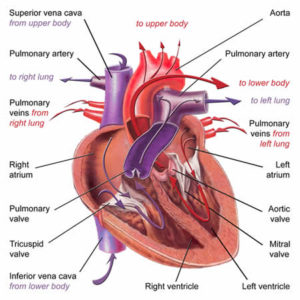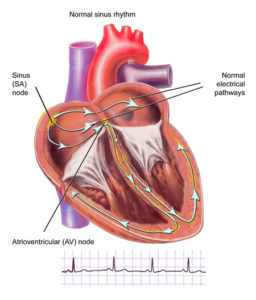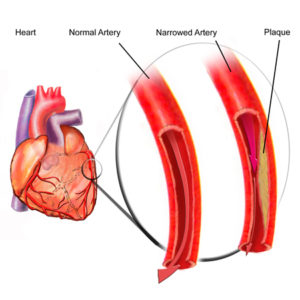The Heart
The average heart will beat over 2.5 billion times during a lifetime. Despite this astonishing fact, the heart is essentially simply a muscular pump, circulating blood containing oxygen and other essential nutrients around the body, and delivering waste products to the kidneys and lungs. Each time the heart beats, approximately 70 times every minute, a cycle takes place; oxygen-rich blood from the lungs collects in the left atrium, passing through the mitral valve into the left ventricle. As the left ventricle begins to contract, the mitral valve closes and blood is ejected through the aortic valve and into the aorta, where it is distributed to the other organs and tissues of the body. Blood returning from the body collects in the right atrium, and in a similar fashion to the left side of the heart, passes through the tricuspid valve into the right ventricle, where it is then pumped through the pulmonary valve to the lungs.

For the heart to pump effectively it requires a regular and reliable heart beat, which it derives from its own electrical conduction system, and its own blood supply, which it receives from the three coronary arteries.
The heart has its own electrical wiring system, which transmits an electrical pulse along predefined pathways; this electrical impulse originates in the heart’s own pacemaker, the sinoatrial (SA) node. This emits an electrical pulse at a rate determined by the body’s requirements; the pulse slows whilst sleeping, but increases with exercise, fever and emotional stress, for example. The electrical pulse wave spreads from the right to the left atrium, triggering muscular contraction of these structures and passage of blood into the ventricles. The electrical impulse then reaches the centre of the heart at a structure called the atrioventricular (AV) node, which acts like a junction box to regulate the flow of electrical impulses from the atria to the ventricles. The impulse then passes into a structure called the Bundle of His, which divides into left and right branches to the left and right ventricles. Specialised conduction fibres called Purkinje fibres conduct the impulse rapidly to the ventricular muscle, causing contracting of the muscle, which ejects the blood into the main arteries, the aorta and pulmonary artery. This complex sequence, called sinus rhythm, creates a highly efficient pumping action by the heart. Deviation from this rhythm can translate into symptoms such as palpitations, dizzy spells and blackouts.

Like any muscle or organ, for the heart to carry out its function it needs a supply of blood and oxygen, which it gets from the coronary arteries. When these arteries are healthy they deliver a flow of blood to the heart muscle appropriate to the activity being undertaken, for example, a faster flow during exercise when the heart is beating harder and faster, than during sleep when the heart rate will naturally be much lower. If the lining of a coronary artery has become narrowed with cholesterol and other deposits, the blood and oxygen supply to the heart muscle during stress becomes inadequate. Furring up of the arteries develops over many years and can occur both gradually and suddenly; gradual progression of the furring up process typically causes symptoms such as chest pain and breathlessness however, another manifestation of the same disease process is a myocardial infarction, or heart attack.
